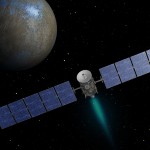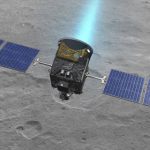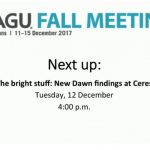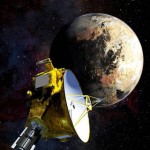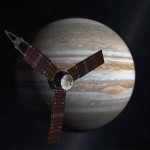2017/12/13

The bright spots in the center of Occator Crater on Ceres are shown in enhanced color in this view from NASA’s Dawn spacecraft.
セレスのオッカトルクレーターにある光り輝いている部分は、NASAの探査機ドーンからみた状態で色を強調処理してあります。
Credits: NASA/JPL-Caltech/UCLA/MPS/DLR/IDA/PSI/LPI
Full image and caption
オリジナル記事:Dawn Identifies Age of Ceres’ Brightest Area
The bright central area of Ceres’ Occator Crater, known as Cerealia Facula, is approximately 30 million years younger than the crater in which it lies, according to a new study in the Astronomical Journal. Scientists used data from NASA’s Dawn spacecraft to analyze Occator’s central dome in detail, concluding that this intriguing bright feature on the dwarf planet is only about 4 million years old — quite recent in terms of geological history.
セレリア発光部として知られているセレスのオッカトルクレーターの明るく輝いている中心部は、天文学雑誌に掲載した新しい研究によると、その輝いている部分はクレーターよりも約3,000万年若いものです。科学者たちはNASAの探査機ドーンの観測データを使ってオッカトルクレーターの中心ドームを詳細に分析しました。この準惑星で発見された興味深い明るい地表は、地質学的な歴史としては最近ともいえる約4百万年前のものだと結論付けました。
Researchers led by Andreas Nathues at the Max Planck Institute for Solar System Research (MPS) in Gottingen, Germany, analyzed data from two instruments on board NASA’s Dawn spacecraft: the framing camera, and the visible and infrared mapping spectrometer.
ドイツのゲッティンゲンにあるマックス・プランク・ソーラーシステム研究所(MPS)のアンドレア・ナシューの研究者グループは、NASAの探査機ドーンに搭載したフレーミングカメラと可視・赤外線マッピングスペクトロメーターの2つの装置のデータを分析しました。
The new study supports earlier interpretations from the Dawn team that this reflective material — comprising the brightest area on all of Ceres — is made of carbonate salts, although it did not confirm a particular type of carbonate previously identified. The secondary, smaller bright areas of Occator, called Vinalia Faculae, are comprised of a mixture of carbonates and dark material, the study authors wrote.
この新しい研究は、以前に特定されたセレスの地表にある明るく輝いて見えているのは特定の炭酸塩による反射性物質であるというドーンチームの初期の解釈を支持しています。しかしながら今回は特定の炭酸塩を確認できていません。ヴィニリア発光部と呼ばれるオッカトルクレーターの2番目の小さな明るい領域は、炭酸塩と暗色物質の混合物で構成されていると研究者たちは書き記しています。
New evidence also suggests that Occator’s bright dome likely rose in a process that took place over a long period of time, rather than forming in a single event. They believe the initial trigger was the impact that dug out the crater itself, causing briny liquid to rise closer to the surface. Water and dissolved gases, such as carbon dioxide and methane, came up and created a vent system. These rising gases also could have forced carbonate-rich materials to ascend toward the surface. During this period, the bright material would have erupted through fractures, eventually forming the dome that we see today.
新たな証拠によれば、オッカトルクレーターの明るいドームは1回だけの出来事で形成されるのではなく、長い期間にわたるプロセスで上昇してできた可能性が高いことも示唆されています。科学者たちは、最初のきっかけは火口そのものを掘り起こすような出来事があって、表面に近くまで明るく輝く液体を上昇させたのだと考えています。二酸化炭素やメタンなどの水と溶存ガスが発生して噴出孔を作り出しました。そこに上昇してきたガスが炭酸塩に富む物質を地表に向かって押し出した可能性があります。この期間中に、明るく輝く物質が割れ目から噴出し、最終的に今日見るドームを形成していったと考えられます。
The spacecraft is currently on its way to a high-altitude orbit of 12,400 miles (20,000 kilometers), and to a different orbital plane. In late spring, Dawn will view Ceres in “opposition,” with the sun directly behind the spacecraft. By measuring details of the brightness of the salt deposits in this new geometry, scientists may gain even more insights into these captivating bright areas.
探査機は現在12,400マイル(20,000キロメートル)の高高度軌道から別の軌道面に向かっています。晩春にはドーンはセレスの「反対側」を探査機の背に太陽を背負った位置関係で見ることができます。この新しい位置から塩析出物の明るさを詳細に測定することにより、科学者はこれらの謎に包まれた明るく輝く地帯についてより多くのことがわかると期待しています。
The Dawn mission is managed by JPL for NASA’s Science Mission Directorate in Washington. Dawn is a project of the directorate’s Discovery Program, managed by NASA’s Marshall Space Flight Center in Huntsville, Alabama. UCLA is responsible for overall Dawn mission science. Orbital ATK Inc., in Dulles, Virginia, designed and built the spacecraft. The German Aerospace Center, Max Planck Institute for Solar System Research, Italian Space Agency and Italian National Astrophysical Institute are international partners on the mission team. For a complete list of mission participants, visit:http://dawn.jpl.nasa.gov/mission
More information about Dawn is available at the following sites:
http://www.nasa.gov/dawn
http://dawn.jpl.nasa.gov
Elizabeth Landau
Jet Propulsion Laboratory, Pasadena, Calif.
818-354-6425
elizabeth.landau@jpl.nasa.gov
Last Updated: March 9, 2017
Editor: Tony Greicius
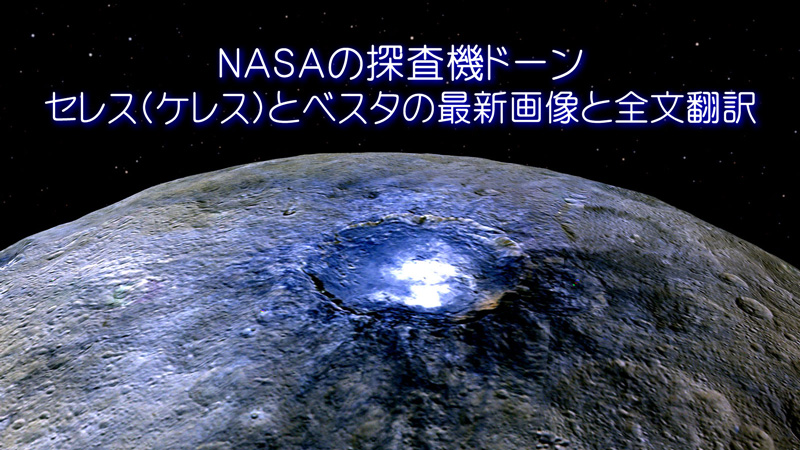
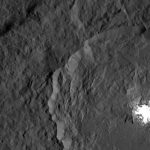
![ついに決着!セレスの謎の発光部の正体 [2016.06.30] ついに決着!セレスの謎の発光部の正体 [2016.06.30]](https://ceres.kyoto-svp.com/wp-content/uploads/2016/07/pia20693_main-150x150.jpg)
